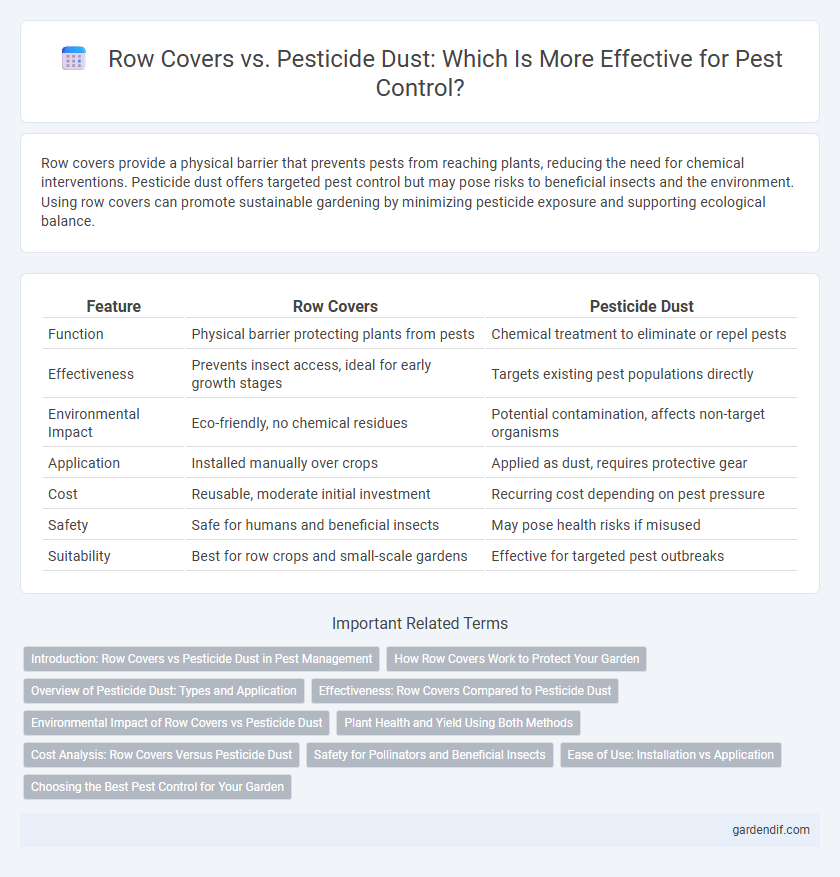
Row Covers vs Pesticide Dust Illustration
Row covers provide a physical barrier that prevents pests from reaching plants, reducing the need for chemical interventions. Pesticide dust offers targeted pest control but may pose risks to beneficial insects and the environment. Using row covers can promote sustainable gardening by minimizing pesticide exposure and supporting ecological balance.
Table of Comparison
| Feature | Row Covers | Pesticide Dust |
|---|---|---|
| Function | Physical barrier protecting plants from pests | Chemical treatment to eliminate or repel pests |
| Effectiveness | Prevents insect access, ideal for early growth stages | Targets existing pest populations directly |
| Environmental Impact | Eco-friendly, no chemical residues | Potential contamination, affects non-target organisms |
| Application | Installed manually over crops | Applied as dust, requires protective gear |
| Cost | Reusable, moderate initial investment | Recurring cost depending on pest pressure |
| Safety | Safe for humans and beneficial insects | May pose health risks if misused |
| Suitability | Best for row crops and small-scale gardens | Effective for targeted pest outbreaks |
Introduction: Row Covers vs Pesticide Dust in Pest Management
Row covers provide a physical barrier that prevents pests from reaching plants, reducing the need for chemical interventions. Pesticide dust offers a direct application method to target and eliminate insects but may carry risks of environmental contamination and resistance development. Choosing between row covers and pesticide dust depends on crop type, pest infestation level, and integrated pest management goals.
How Row Covers Work to Protect Your Garden
Row covers create a physical barrier that prevents insects and pests from reaching garden plants, reducing the need for chemical interventions. By blocking sunlight and airflow minimally, these covers maintain a favorable microclimate that promotes healthy plant growth. Unlike pesticide dust, row covers offer a chemical-free, eco-friendly method of pest control that also protects beneficial insects.
Overview of Pesticide Dust: Types and Application
Pesticide dust consists of finely ground particles containing active chemical ingredients designed to control pests on crops. Common types include carbaryl, malathion, and sulfur dust, each targeting specific insects or fungal issues through direct application. This method enables targeted pest control but requires careful handling to minimize environmental impact and human exposure.
Effectiveness: Row Covers Compared to Pesticide Dust
Row covers provide a physical barrier that prevents pests from reaching plants, offering effective long-term protection without harmful chemical residues. Pesticide dust, while potentially faster acting, can lose effectiveness over time due to pest resistance and environmental factors like rain and wind. Combining row covers with targeted pesticide use can enhance overall pest control efficacy while minimizing chemical exposure.
Environmental Impact of Row Covers vs Pesticide Dust
Row covers significantly reduce environmental pollution by providing a physical barrier that limits pest access without chemical runoff, preserving soil and water quality. Pesticide dust often contaminates surrounding ecosystems, affecting non-target organisms and contributing to soil degradation and water pollution. Choosing row covers promotes sustainable agriculture by minimizing chemical exposure and protecting biodiversity.
Plant Health and Yield Using Both Methods
Row covers provide a physical barrier that protects plants from insects and diseases, promoting healthier growth and reducing the need for chemical interventions. Pesticide dusts, when applied correctly, can effectively control pest populations but may risk harming beneficial insects and plant health. Combining both methods optimizes plant protection, ensures higher yields, and minimizes environmental impact by reducing pesticide reliance.
Cost Analysis: Row Covers Versus Pesticide Dust
Row covers offer a cost-effective pest control solution by reducing the need for repeated applications compared to pesticide dust, which requires frequent reapplication and additional safety equipment. Initial investment in row covers may be higher, but their durability and reusability lower long-term expenses and minimize environmental impact. Pesticide dust involves ongoing costs related to chemical purchases, application labor, and potential crop damage from chemical exposure.
Safety for Pollinators and Beneficial Insects
Row covers create a physical barrier that protects crops from pests without exposing pollinators and beneficial insects to harmful chemicals, ensuring their safety and ecological balance. Pesticide dust, while effective in pest control, can contaminate flowers and plants, posing significant risks to bees, butterflies, and other beneficial insects essential for pollination. Choosing row covers supports sustainable pest management by reducing chemical exposure and preserving pollinator health.
Ease of Use: Installation vs Application
Row covers provide a straightforward installation process by simply draping fabric over plants and securing edges, requiring no special equipment or timing considerations. Pesticide dust application involves careful timing, protective gear, and precise dispersion to ensure effectiveness and safety. The physical effort and complexity of handling pesticides often make row covers a more user-friendly option for pest management.
Choosing the Best Pest Control for Your Garden
Row covers provide a physical barrier that prevents pests from reaching plants, reducing the need for chemical intervention and promoting organic gardening. Pesticide dust offers targeted pest eradication but may harm beneficial insects and contribute to environmental toxicity. For sustainable pest control, select row covers to protect crops naturally while monitoring pest levels before considering pesticide dust as a supplementary solution.
Row Covers vs Pesticide Dust Infographic

 gardendif.com
gardendif.com